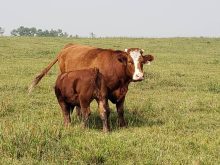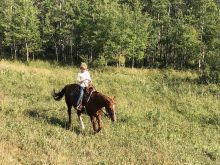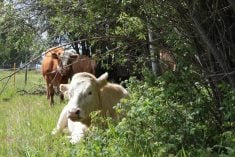For years, I have seen cornfields popping up over the Prairies (sorry for the pun). Much of this crop is harvested for corn silage, but significant acres are picked for grain. When just the cobs are harvested there is a tremendous amount of residue left on the ground. This is an abundance of forage for early gestating cows after weaning. I recommend cow-calf operators with access to corn residue, don’t let it go to waste. Graze it as part of your cowherd’s overwinter feeding program as a low-cost feed.
Read Also

Harvest wraps up and fall work begins
At the Eppich famly ranch in western Saskatchewan, the fall harvest was successful with few breakdowns, cows and calves have been sorted and a new tractor has arrived
Corn residue or stover left for grazing is produced when the combine moves from acre to acre leaving cornstalks, leaves, husks as well as intact ears in its wake. It is estimated by the North Dakota State University extension service about 50 lbs. of total residue for grazing beef cows is left behind per bushel of corn harvested. The edible amount is about 25 per cent useable feed due to weather degradation and cattle wastage.
This means if a producer grows a 100-bushel per acre corn crop; it yields approximately 1,250 lbs. of consumable forage by grazing beef cows. Given that a beef cow has a daily dry matter intake of about 25 lbs., corn residue has the potential to support a substantial portion of her nutrient requirements for approximately 50 days (re: 100 x 50 x 0.25 = 1,250, 1,250/25 = 50).
Parties interested in utilizing their corn residue for beef cows should first outline a plan of 40 to 60 post-weaning days; estimating one cow per acre when grain yield from suitable cornfields exceeded 100 bushels per acre. They should also consider doubling this rate to one cow/two acres, which promotes the cows’ natural selective grazing and thus greater access to higher quality portions of available corn residue.
A two-month plan should start within days of the ears being harvested from the crop. This period coincides with the best nutrition provided by corn residues for early to mid-gestation cows.
Because the feed value of corn stover is very comparable to wheat or barley straw, corn residue can support early to mid-gestation beef cows with the right amount and type of nutrient supplements (re: nutrient requirements, which are at their lowest points compared to any other time of the year). Specifically, these cows need to consume about 52 to 55 per cent TDN and eight to nine per cent crude protein feed on a daily basis for body maintenance, to keep warm during the winter and to support an early-term fetus.
Supplement options
There are many energy and/or protein feed supplements available, which compliment an overwintering cow grazing corn stover program. For example, many producers across Western Canada have access to dried distillers’ grains (75 per cent TDN and 28 per cent crude protein). It’s as simple as adding 3.5 lbs. of DDGS which can raise a diet of 23 lbs. of corn residue from five to eight per cent protein.
Other producers rely upon commercial 18 to 30 per cent protein range cubes or pellets, commonly made from the same distillers’ grains and other byproducts such as wheat shorts or canola meal. Although, they tend to be more costly, distillers’ grains- or molasses-based lick blocks (70 per cent TDN and range from 20 to 40 per cent crude protein) can also be supplied on corn stover fields.
Along with these energy/protein supplements, it’s also important to put cows on a well-balanced mineral program either incorporated in these feeds or fed in loose form. Like other corn-based feeds, corn stover is low in calcium (0.20 to 0.25 per cent) and phosphorus (0.15 to 0.20 per cent) and deficient in many trace elements such as copper, zinc and selenium.
It is my personal perference to balance corn stover and independent of added supplements with a loose-fed 2:1 or 18 per cent calcium/nine per cent phosphorus cattle mineral with adequate levels of above trace minerals as well as fortified levels of vitamins A, D and E; fed at 85 to 112 g per head per day. Loose salt can be mixed in with the mineral or fed in blocks.
Look at the costs
With a complete grazing program in place for 60 days, the universal question “Is how much money does grazing corn stover save me?”
Let us consider a straightforward example:
- Conventional grass hay and minerals: 4 cents/lb. x 25 lb. hay + 12 cents of 2:1 mineral and salt + 30 cents/head/d yardage = $ 1.42 per head per day.
- Corn Stover and DDGS and minerals: 1.5 kg of DDGS @ 0.25 + 12 cents of 2:1 mineral and salt + 30 cents/head/d yardage = $ 0.79 per head per day.
- Savings (1) – (2) = $0.63 or 44 per cent
Keep in mind I quickly penciled out the feed cost-savings, given a typical beef cowherd grazing corn stover by determining the cost of conventional feeds it replaces and subtract any purchased feed to supplement any lacking nutrients that the gestating cows may need.
Note: I did not include in my calculation, the initial set-up non-feed costs of possibly providing a new water source, running a solar-powered electric fence throughout the cornfield (control grazing activities) and extra yardage to periodically move this fence. For a more detailed look, beef producers might find it helpful to download the Corn Stalk Grazing Calculator (excel spreadsheet) from the University of Nebraska website.
















